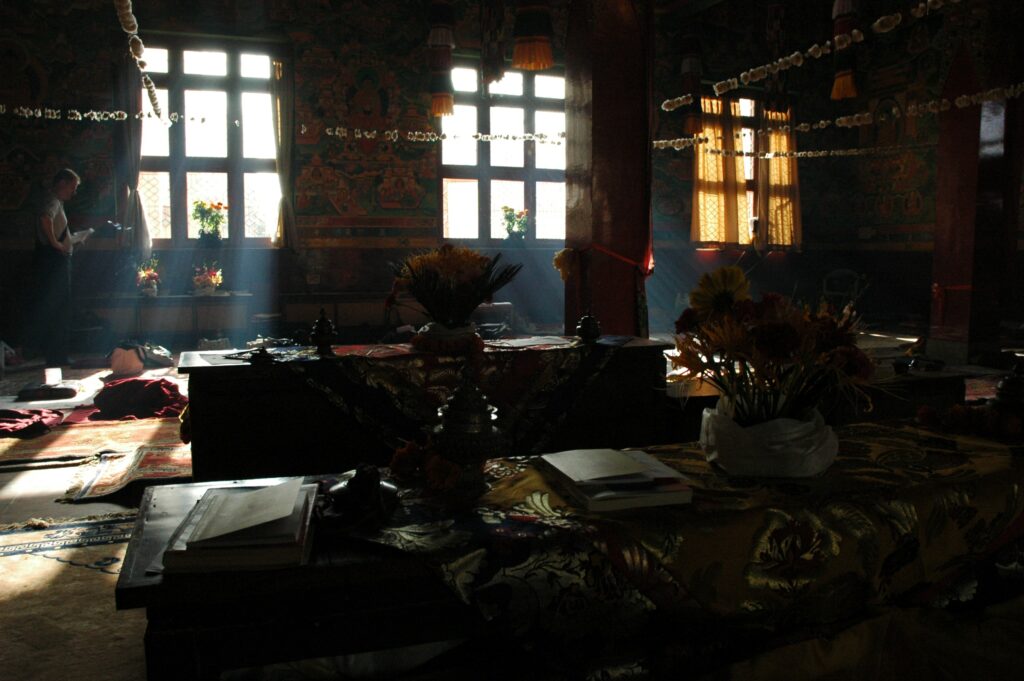(On three year retreat I thought I would keep a journal. There was no time. Well, perhaps there was time, but it soon became clear that there were better things to do with the time. But I did write two essays. this and one other.)

I am mid-way through a three and a half hour Vajrayana ritual service, and I am standing in front of the shrine. The group is chanting at lightning pace. I have approached the shrine in my role as ritual master. I have pulled my tsen–my shawl–up over my left forearm, but I realize I have no idea what comes next. I am asleep.
The shrine is crowded with tentors–colorful, abstract sculptures that are the deities we practice. There are offering bowls and ‘skull cups’ and spoons and candles and incense. There are flowers and food and water–perfumed and plain. There is an endless variety of brocade and piles of rice and dough and brass thing-a-ma-bobs. There is no clue what comes next.
I count. There are fifty things on the shrine. I know the function and meaning of each one, at least to some degree. I have used them, and I know in which hand they are held, and the arc and angle of the hand as it performs its ritual task. Though I have some comfort–and unfortunately, some pride–in knowing these things, this knowledge does not tell me what comes next.
I am listening. The music was cleverly arranged, centuries ago, to give me a narrative clue, wasn’t it? We are living a vajra life in this service. We are born, we meet beings, we do things together and then we dissolve back into nothingness; just as we do in our embodied lives. The music tells the story. The words, chanted in Tibetan, tell the story. The mudras and mantras and even the structure and sequence of the ritual all have embedded meaning as a support for the intended experiences.
We live and die in this world of mind–but ritually, with explicit intention. We create it and we know it. It is an exercise, created by enlightened beings, to bring us out of sleep and into awakened mind. The chant leader picks up the rolmos, the heavy, solemn Tibetan cymbals, and begins to keep time with the chanting. I feel the vibration in my chest. Suddenly my right hand knows what to do. Only seconds have passed since I stood up and came to the shrine. I am awake.
Form is a container inside which we practice. Every moment has meaning and consequence. We practice a form over and over–thousands and thousands of times. Inside the form, each person expresses their individuality. A simple gesture like an offering held in two hands above the head is different for each of us, and different each time we do it–but only if you look very carefully.
It’s possible to do an entire ritual while sleeping. I have done it, I think. I have woken up while extinguishing the candles in an empty shrine room and wondered how it was possible to sleep while standing, while walking, while reciting long passages of un-memorized text. Is it possible to live an entire life like that–completely asleep? The body knows what to do. The mouth speaks, but spiritual intelligence is absent. We are vacant. Automated, but empty. The whole culture moves and carries you along, drowsy and anesthetized. It is possible, I think to myself. I have narrowly escaped it. I am sweeping the rice from the shrine room floor. I feel the weight of my body shifting from left foot to right, the small muscles of my hands guiding the broom. The handle is smooth and worn.
It is snowing outside. A small bird sits on the fence, its head tilted, as if to listen. My breathing is even and relaxed. I like sweeping, and I say to myself, “I am awake.”
